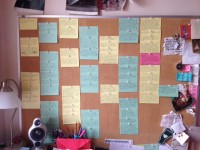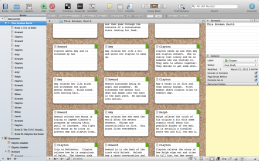Hello, reader, and welcome (back) to Writer Central!
An exciting thing happened to me today! I finished my outline! I decided to go back and make an outline for my current manuscript, The Daughter of Darkness (working title). So I thought today’s post should be on outlining a novel, since that crap’s still drilled in my head.
Is outlining really important? Sure, it organizes your thoughts, but it’s so hard and time consuming. This is one of the reasons that many writers opt to pantsing it. But I discovered last year that the difficulties of outlining are SO worth it in comparison to the alternative. Zero outlining tends to result in a trashy manuscript. So, even though my story was written, I went through and connected some plot points to decide what was i.
I’ve tried so many kinds of outlining, but I think I finally found one that works well for me.
Now I’m going to go through and name some of the most popular and efficient types of outlines.
1. the sticky note method

This is my current method. There are many ways you can do this – you can stick Post-it notes to your wall, a white board, a notebook. It’s a great way to organize your thoughts in a place where they can easily be moved or handled. I like using a whiteboard, because it lets me write notes and things around the Post-its.
With my outline (shown in the picture on the right), I wrote major plot points on each Post-it and put them in chronological order. I labeled each Post-it with the chapter number and the character who was narrating. Then I color-coordinated it and labeled each section. The pink section is the exposition, or set up. This is where the character and setting is introduced and somewhat explained. The large green sticky note is the inciting incident, or the incident that sets off the plot. The purple sticky notes are Act I of the rising action, and the yellow sticky notes are Act II of the rising and falling action, as well as the conclusion. The large green sticky note is the climax.

2. the thumb tack method
I’ve personally never used this method, but it’s very similar to the sticky note method. The only difference is that you use notecards and stick them into a corkboard or the wall. I chose not to use this, because I like being able to make notes along the sides of the outline.

3. the floor method
The floor method is very basic. Write down all your major plot points on notecards and arrange them on the floor. Then build off of that, adding subplots and such. Just be careful not to leave it out because it’ll probably get messed up super quick. (Here’s a reference video on outlining that uses this specific technique: How to Outline Your Novel.)

4. the technical method
This one’s last because it’s the one I least recommend, but I’ll plant the idea in your heads anyway. You can always outline using an app on your phone, or through a regular document on your laptop or some other device. The only reason I don’t advise this is that most people like to hands-on outline. Using a device can be extremely frustrating and confusing. However, I do suggest that once you have your outline generally figured out, you should set it up on your computer as easier reference for when you’re writing.
These are four of the main methods I’ve used or heard of. Of course, some may work for you better than others. Perhaps none will work for you. If you outline using a different method than the ones above, I would love to hear about it. You might also think you’re a pantser, but even if you think this, I suggest you use an outline anyway. Outlining is crucial to professional novel-writing, so if you want a shot at publication, outlining is a must.
Now, I found a post on Writer Wonderland, a blog by Izzy Shows, that I wanted to share with you guys.
You Need an Outline
We’ve all seen it happen a lot, maybe more than others if you happen to frequent the NaNoWriMo forums. Much love to wrimos, this is not a diss on the NaNo format, I wouldn’t have gotten to my current writing place if it weren’t for that group.
Pantsers. People who write without an outline, without a plan in place, or even a concept of where the story is going. All you know is the idea that jumped into your head a moment ago, and maybe some of the details of your cast.
You might be thinking, Hey! That’s just because I’m so inspired by the story, I don’t have time to sit down and plot it all out when I could be writing! Isn’t that the whole point of being a writer, actually writing?
Well…yes and no. Yes, writers write. That’s what defines us as a species. But to get a functional novel that you don’t have to completely rewrite afterwards…you need to know where it’s going. You have to have more than just a sparkling idea that excites you.
Think about it like a relationship. Good looks are the spark that carries you into NRE(New Relationship Energy), but without a solid foundation that relationship will fizzle out and you’re going to break up sooner or later. Hopefully sooner, or else you’re going to have wasted a lot of time.
Writing a book is exactly the same. Sometimes NIE(New Idea Energy) will carry you half way through the book, sometimes only a few pages, but you will always hit that point where you wonder why this was even a good idea to begin with, and where is it all going? Some novelists will continue to bang out the words with the motto in mind that “every rough draft sucks” and “everyone has to rewrite anyways.” And while it’s true that the grammar, formulation of a scene, or balance of show and tell likely suck in most first drafts…a well plotted story won’t need an actual rewrite.
If you’re defending your time so fiercely, why not actually put in the effort to make a solid outline that will carry you through the moments of doubts and what if’s, so that you can write the story you want to write…the first time.
Build the foundation, move past NIE, and love your novel.
That’s all for today! If you have a question, comment, or idea, please drop it below or contact me. If you liked this post, there’s more where it came from! Feel free to follow my blog as well.
See you next time! ❤
